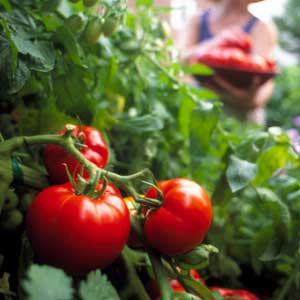

When spring fever arrives, many of us begin to imagine lush, productive vegetable gardens and all the goodies that come with it. There is a lot of prep work to ensure you will have the garden eutopia of your dreams. Along wth soil conditioning, proper site selection, and moisture, temperature is key. Although you may crave that first vine ripened tomato or pepper of the year, your transplants will suffer substantial stress if they are planted too soon, and will go into a holding pattern until the weather breaks. If it is too cold, seeds will not germinate at all. Regardless of whether you are planting seeds or transplants, or targeting weeds, it is important to know soil temperature before beginning. Cole crops, lettuce, radishes and peas will germinate under soil temperatures of 45-50 degrees. A warm rain (a nice thunderstorm) will cause soil temperatures to raise nicely.
Crops should be planted within the parameters of conditions that best suit them individually. Most have recommended minimum ground temperature requirements to enable success. An excellent way to determine your ground temperature, according to Norm, is to take a soil thermometer, or any thermometer that has a metal tip, and place it at least 4-6 inches into the ground for transplants and 1-2 inches for seeds, allow a few minutes for the temperature to register, and take your reading. You should take your readings on three consecutive days. You could also take your reading multiple times during the day, say morning and late afternoon, and average the two temperatures, again for the three consecutive days. Remember to take readings from all four sides of your house, as there can be substantial variation based on exposure. This spring in particular ground temperatures are lower than normal. A good indication of how delayed the season is can be seen by observing your blooming shrubs like forsythia, magnolias and lilacs and where they are in the bud/bloom cycle. Look around your yard and observe how far your perennials are up, if at all, and your bulbs like daffodils, tulips and crocus. Have your peonies or iris awakened yet? Chances are, especially on the shady North side of your home, that things are progressing a little slower than usual.
With regards to weed control in your lawn, specifically crabgrass, pre-emergents should be applied around lilac bloom time, or ground temperature of 50 F or higher. Norms says his best indicator is when the lilac buds start to show color. Do not apply pre-emergents in areas where you plan to have newly seeded grass. They lose their effectiveness when you rake or disturb the soil, as the pre-emergent barrier is broken. The earlier you apply it, the sooner it loses its effectiveness. Apply a pre-emergent too late, and it is useless against established weeds. Once the soil temperatures have reached 55-60 degrees approximately four days in a row, your crabgrass will start to germinate and a pre-emergent will not help. The best defense against crabgrass is a thick vigorous lawn mowed no shorter than 2 1/2 inches for cool season grasses. Crabgrass can be pulled by hand and is easiest to remove after a heavy rain. If you have too much to pull by hand, a post emergent herbicide will do the trick. This should be applied when the crabgrass is in the 3-4 leaf stage of development.
For gardening success, pay close attention to timing and temperature. When the soil finally reaches that optimum temperature to begin planting, follow these steps for further success.
1. Water your transplants in throughly before planting.
2. Do not disturb the root ball when you plant.
3. Plant on a cloudy or overcast day if you can to minimize stress.
4. Water the newly transplanted plants in again immediately.
Water, weed and feed as necessary. Eagerly await harvest and enjoy!

| Norms Greenhouse and Nursery LLC 21366 476th Street Aurora, SD 57002 (605)-693-3926 |
|
CLOSED SUNDAYS. |
|
© 2015-2024 Norms Greenhouse and Nursery LLC |